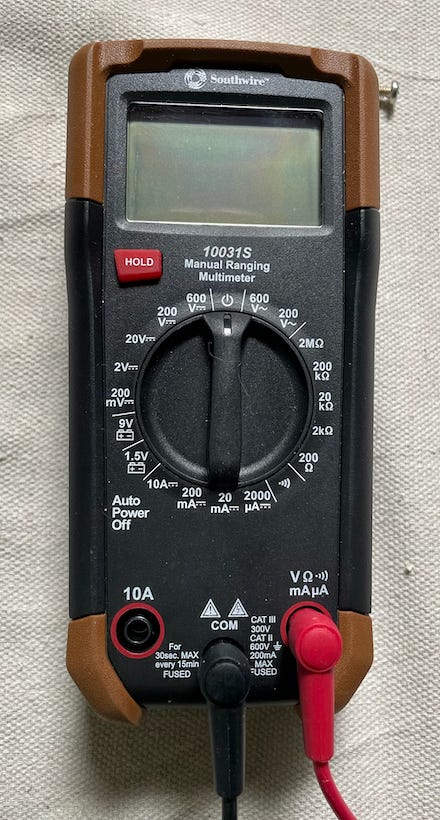Nobody get excited!
This article is not about actual short circuit wiring. I’m introducing a series of short format articles about testing electrical circuits. So I’m calling them Short Circuits to differentiate these quickie articles from my long-form 2,000 to 3,000-word deep dives.
Failure of the teacher to teach
Earlier this week I made an assumption about the base knowledge level of someone I was on the phone with while walking them through how to measure an outlet with a digital multimeter. And while I thought I was doing a good job, my trainee was getting terribly frustrated because the brand new meter she just bought wasn’t working at all.
Every picture tells a story…
I had assumed that she didn’t have the probes plugged into the meter correctly, so I had her send me a picture. And while she did have the probes insterted into the correct meter inputs, she didn’t realize that the connectors needed to be twisted and plugged in flush.
Swing and a miss…
So Strike 1 for me for not realizing that someone who has never used a multimeter didn’t know that the meter leads needed to be pushed in all the way.
But still the meter wasn’t working at all, even though I had her do a basic continuity test. It was giving wild readings and acted like a broken wire in a meter lead. So I had her set the scale to 200 volts AC (~) and asked her to put the meter probes into the 15-amp wall outlet she really needed to test. But she commented that she couldn’t get the probe tips pushed into the wall outlet.
Strike 2 on me
I didn’t pick up on that hint, and she needed to leave for a doctor’s appointment and said she would call when she got back. A few hours later she called and said she had figured it out. She watched a video on how to test a wall outlet and found out that the plastic covers on the probe tips needed to be removed!
And since these probe covers leave only the very tips of the metal probes exposed to limit shock and short-circuit hazards, she couldn’t make steady contact for a resistance/continuity reading. And the plastic sheath on each probe tip was too large to allow it to be plugged into the wall outlet.
She was actually giving me hints as to what was wrong, but I ignored them because I had assumed everyone knew that you need to remove the probe tips to reach the contacts in an electrical outlet. So Strike 2 on me!
That when I decided to create “Short Circuits”
So I’ll publish at least one of these short articles or videos each week on basic electrical concepts. Since many of you have never held a meter in your hands and a lot of the words I use sound like “Greek” to non-technicians, I’ll intersperse my technician/engineering-level articles with simple-concepts.
Please let me know if there’s anything you’re confused about in electrical systems and I’ll try to break it down into the basics.
Let’e play (and learn) safely out there… Mike








Holy cow this is fantastic! Please keep this up I have so many elementary gaps in my knowledge and most of the time I don’t even replicator!
Excellent! And photos like you posted really help.